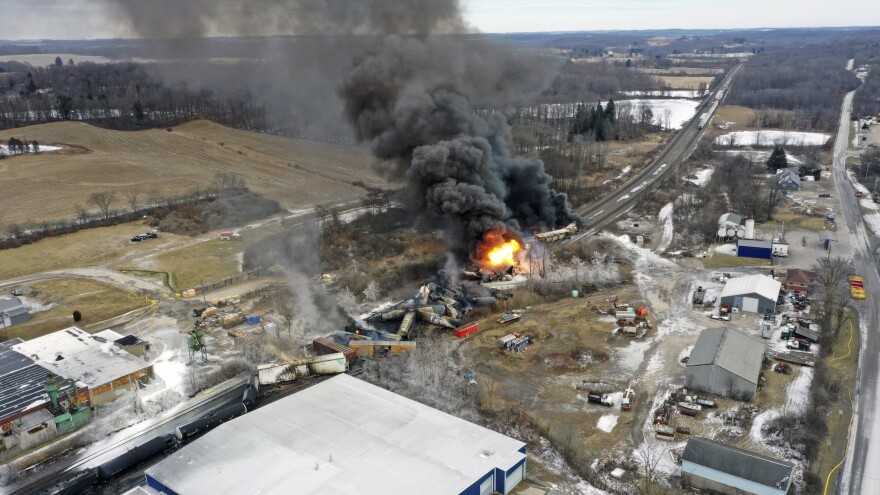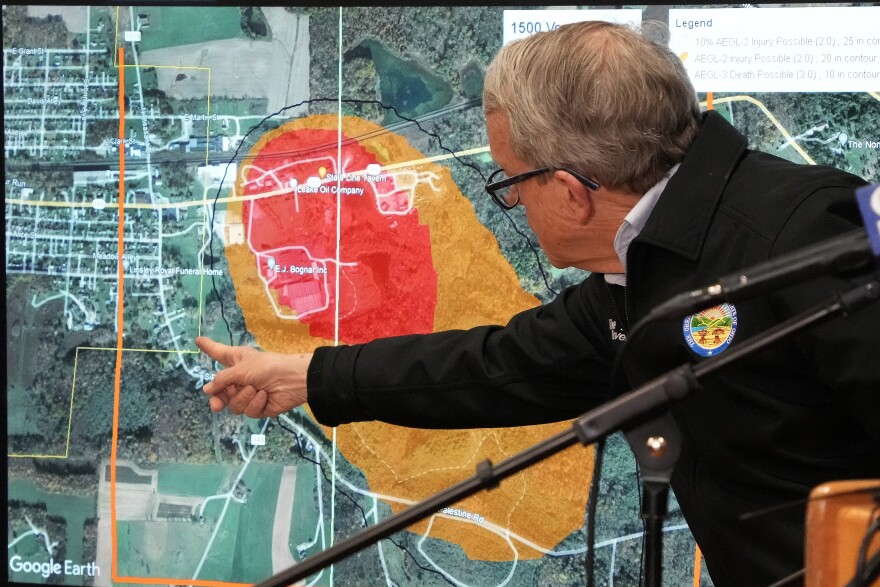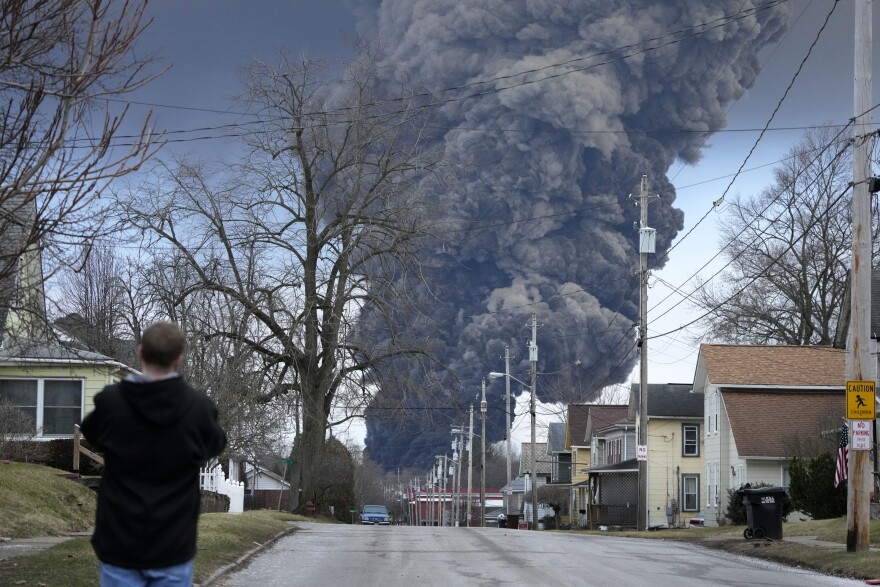EAST PALESTINE, OHIO — A day after crews released and burned toxic chemicals transported by a wrecked train in Ohio, residents remain in the dark about what toxic substances could be lingering in their evacuated neighborhoods.
About 50 cars, including 10 carrying hazardous materials, derailed in a fiery crash Friday night in East Palestine near the Pennsylvania border, according to rail operator Norfolk Southern and the National Transportation Safety Board.
- A train derailed in a fiery crash Friday in Ohio, near the Pennsylvania border
- The train was operated by Norfolk Southern, which also runs trains through the heart of the Lehigh Valley
- There are federal guidelines in place that establish emergency response, including evacuation distances, when a train accident involves the release of toxic gas, flammable materials, or explosives
Ohio Gov. Mike DeWine earlier ordered evacuations in the area of the derailment, which has been smoldering since Friday night.
Vinyl chloride was slowly released into the air Monday from five of the 10 derailed cars before crews ignited it to get rid of the highly flammable, toxic chemicals in a controlled environment, creating a dark plume of smoke.
The impact of burning vinyl chloride is a concern.

WHAT IS VINYL CHLORIDE?
The gas is used to make the polyvinyl chloride hard plastic resin in plastic products. It is found in products such as credit cards, furniture and car parts, but is most notably used in PVC plastic piping, a common material for plumbing.
IS IT DANGEROUS?
Vinyl chloride is associated with increased risk of liver and other cancers, according to the U.S. National Cancer Institute.
The effect was studied in PVC pipe makers, who breathed in vinyl chloride and developed rare liver cancers, said Ruth Lunn, who studies carcinogens at the National Institute of Environmental Health Sciences.
“If you worked longer, you had a higher risk, and if your exposure levels were high, you had a higher risk," Lunn said.
Vinyl chloride is dozens of times less toxic per molecule than the U.S.-banned insecticide DDT but more dangerous per part than ammonia and natural gas, according to federal regulations that dictate acceptable levels in the air.
WHAT HAPPENS WHEN IT BURNS?

Officials warned the controlled burn would send phosgene and hydrogen chloride into the air. Phosgene is a highly toxic, colorless gas with a strong odor that can cause vomiting and breathing trouble and was used as a weapon in World War I.
Phosgene is considered safe at 0.1 parts per million during an eight-hour exposure, or 0.2 ppm for a 15-minute exposure. The eight-hour exposure threshold would have to be even lower when measuring inside people’s homes, where residents often spend more than eight consecutive hours.
Hydrogen chloride is a colorless to yellowish gas with a strong odor and its primarily effect on humans is skin, eye, nose and throat irritation. It is considered safe at 5 ppm for an eight-hour exposure.
WHAT IS BEING MONITORED?
James Justice of the U.S. Environmental Protection Agency said a network of air station monitors inside and outside the evacuation zone was collecting samples and that none of their readings found anything to be concerned about.
“We want to make sure that’s not going to change,” Justice said.
Justice said the agency still is working with experts to determine safe levels for various gases before reopening the evacuation zone. The incident response team did not specify what substances they are monitoring.
The gases that experts suspect are in the area are heavier than air, which means they could be sitting in low-lying areas if not completely dissipated.
National Guard members wearing protective gear are taking readings inside homes, basements and businesses, Maj. Gen. John Harris Jr. said.
The EPA also sampled nearby rivers to determine whether there has been any water contamination and is awaiting results.
WHEN WILL THE RISK BE OVER?
Whatever chemicals are in the air, gases largely dissipate fairly rapidly when out in the open, said George Gray, a public health professor at George Washington University. “Sunlight can change that, the movement of air can change that, temperature can change that.”
Residents are concerned about long-term effects of low-grade exposure.
“There’s all that smoke and all those chemicals in there," said Mason Shields, who lives in East Palestine and visited an aid center outside the evacuation zone.
“I’m wondering if it’s even going to be safe for people to return within the next week or month or however long.”
COULD IT HAPPEN HERE?
Railroad tracks wind through Lehigh Valley neighborhoods and beyond, and the trains that use them also are operated by Norfolk Southern and may haul hazardous materials.
The Lehigh Line carries dozens of trains a day, running from Port Reading Junction in Manville, New Jersey, to Penn Haven Junction in Lehigh Township, Carbon County. It crosses the Delaware River at Phillipsburg, New Jersey.
The majority of the trains on the Lehigh Line are intermodal trains, carrying trailers and containers to and from ports and businesses. But some also carry hazardous commodities, which are required to be identified by proper shipping name and hazard class and must include all other information required by regulations of the U.S. Transportation Department.
If dangerous chemicals escaped in a Lehigh Valley train derailment, an untold number of people could face evacuation orders.
According to the American Association of Railroads, advanced technologies are being used to monitor network infrastructure and equipment of freight railroads.
Since 2000, America’s Class I railroads have spent $439 billion on network maintenance and capital expenditures while the train crash rate dropped 33%, AAR's website reports.
There also are federal guidelines in place that establish emergency response, including evacuation distances, when a train accident involves the release of toxic gas, flammable materials, or explosives.
___
Borenstein reported for the Associated Press from Kensington, Maryland. Patrick Orsagos contributed from East Palestine, Ohio.
LehighValleyNews.com also contributed to this report.

